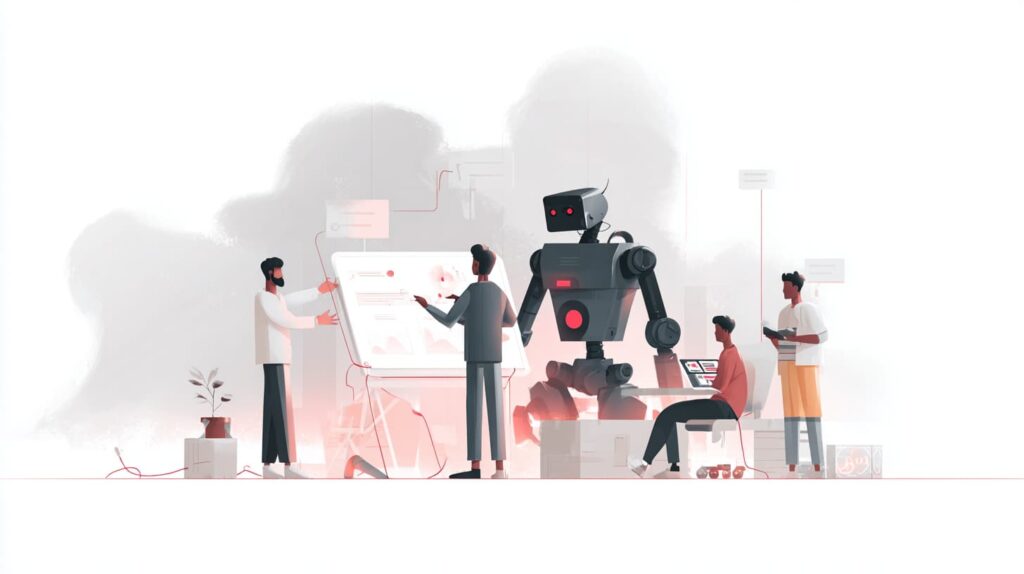By Gabriel Renault
- Generative Artificial Intelligence represents a revolution in productivity that will have an estimated annual gain of more than US$ 4 trillion in multiple industries.
- On the other hand, some human professional markets are likely to shrink as functions are incorporated by the machine.
- This article discusses the future of work, ways of dealing with the impact of Generative Artificial Intelligence, and how to prepare for this great revolution that is already underway.
At this point, it is no longer possible to deviate from the subject: Generative Artificial Intelligence (GenAI), with the force of its impact, will transform everybody’s work. But how exactly will this happen? What information do we have today that can help us understand how the job market will be affected by the disruptive wave of this technology?
Although the current rapid pace of Artificial Intelligence systems’ development has been surprising us with unexpected leaps (such as the launch of ChatGPT in November 2022, or the incredible demonstrations of the Sora text-video model, both by OpenAI), which makes it difficult to predict the future of this technology, there is a strong consensus among experts in the field on at least one point: the new Generative AI models will have a strong and worldwide impact on the way people work.
According to the current managing director of the International Monetary Fund (IMF), Kristalina Georgieva, around 40% of jobs could be affected by the development of AI. “Artificial intelligence will transform the global economy”, states Kristalina in an article published on the Fund’s website.
OpenAI’s own CEO, Sam Altman, admitted in an interview with The Atlantic magazine that “some jobs tend to disappear”, while others will be boosted in terms of productivity and creative possibilities.
To discuss this, firstly, a brief recap of some fundamental concepts is in order. And for even more depth, we recommend checking out our Generative Revolution report, which details several of the concepts covered in this article.
After all, what makes up the world of artificial intelligence?
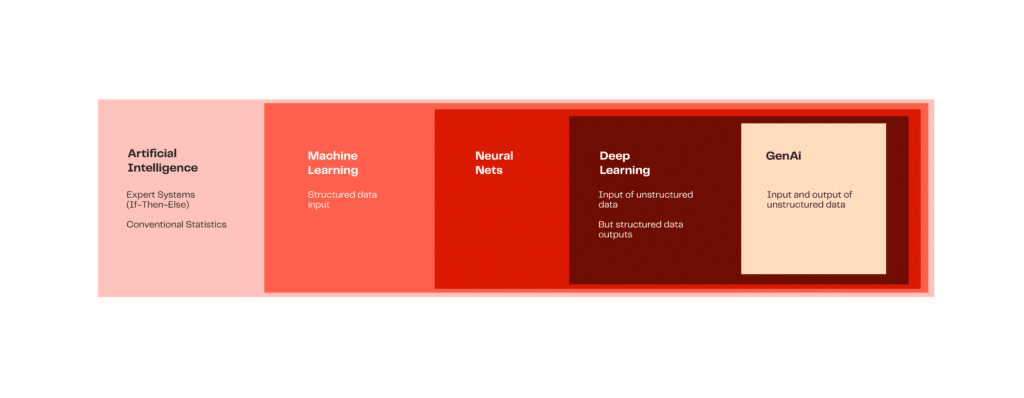
The term “Artificial Intelligence” refers to the entire field of study, based on an academic definition dating back to the English mathematician and computer scientist Alan Turing (1912 – 1954). Conceptually, AI is an interdisciplinary field that seeks to develop systems capable of performing tasks that normally require human intelligence. These tasks include learning, reasoning, problem solving, visual perception and speech recognition.
In the diagram above, the items in the center do not “solve the problems” of those outside. In other words, GenAI itself does not replace the other fields of study, but is a consequence of them. In this diagram, we have:
1. Systems based on logical rules (if-then-else, which are one of the foundations of programming), and Econometric and Statistical Models. Both are (and will continue to be) extremely useful and widely used. In these models, the rules need to be thought out and coded by human beings, which ends up being a major bottleneck because, according to Polanyi’s Paradox: “We always know more than we can express”.
As an example, imagine creating a logical code (if-then-else) to identify the image of a sofa, among many other types of furniture. To do this, you would have to write in the code all the conditionals necessary for the program to eliminate possibilities and narrow down the alternatives until it reaches the sofa, which implies more rigidity and a greater margin for error, considering cases where there is a great complexity of variations, something common in the real world.
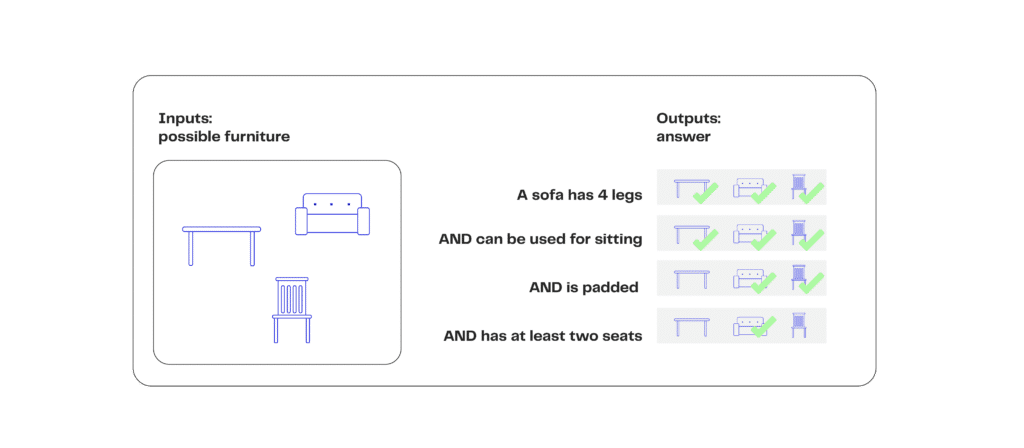
2. Machine Learning is the group of models that learn from data. Here, the programming paradigm changes completely. The models are already built (by different mathematical methods) and the job of training the model consists of using structured data (composed of well-defined rows and columns) in large volumes, so that the model “learns” how to perform the task in question.
In other words, the model “understands” how to do what is required, based on the data (reducing the impact of Polanyi’s paradox). In general, these models will deal with predictions, classifications, inferences, etc. Following the example of the algorithm that identifies sofas, in this case we no longer need to describe the rules that define what a sofa is. It is enough to organize the characteristics of thousands of pieces of furniture in a table or database so that the algorithm itself can learn to identify what is or is not a sofa.
3. Neural Networks and Deep Learning. This group still consists of Machine Learning models, only more specific. Their big difference is that, unlike traditional Machine Learning models, these can process unstructured data (videos, audios or long texts) well. In other words, this group of techniques frees up the human effort of structuring unstructured data. However, for these models, despite the unstructured input, the output is always structured (a number or a specific category).
Following the example of creating a database of furniture characteristics, using these techniques, it is enough to have a large set of furniture images that only say whether it is a sofa or not a sofa, and the model will learn to identify this type of furniture just from the classified images.
4. Generative AI. This model is a type of Deep Learning which, as well as being able to receive unstructured inputs (texts, images or audio), can also generate an unstructured output.
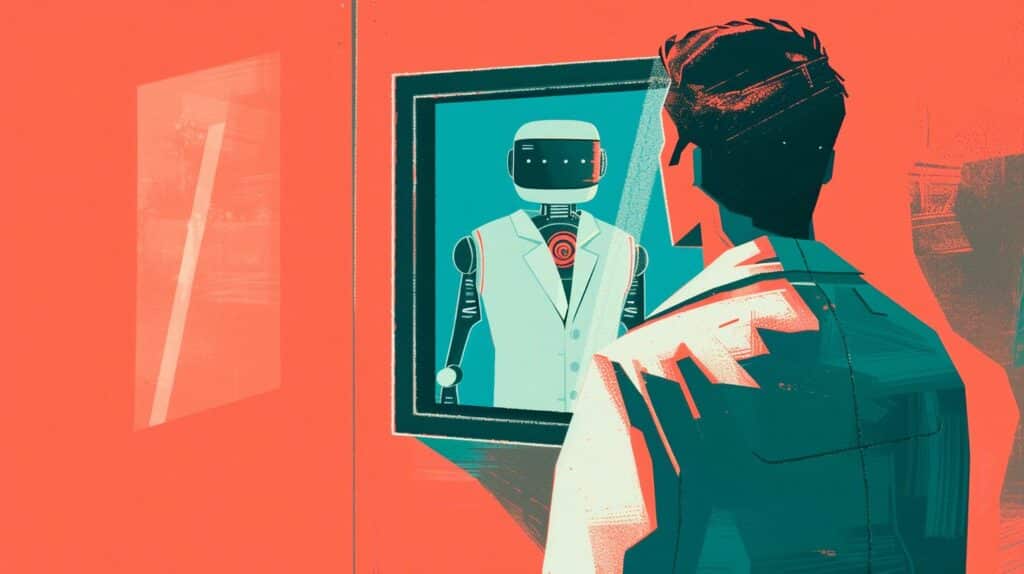
Okay... But what does this have to do with me?
With an estimated annual impact on the global economy in different industries of up to US$ 4.4 trillion as a result of increased productivity, according to an analysis by a consultancy, the effects of the large-scale implementation of Generative Artificial Intelligence models will be felt in different professional profiles at different speeds.
Generally, more “technical” jobs tend to be more at risk than those involving elements such as creativity, abstraction and empathy, which are considered to be “human” traits.
It is worth highlighting that this could all change, considering that state-of-the-art models are continually developing in terms of competencies. But we will talk about “AGI” (Artificial General Intelligence) later in this article.
Some examples of professions immediately impacted by current progress in this field:
- In the case of customer service, highly intelligent chatbots specialized for the reality of each company and their respective businesses will open extremely efficient contact fronts, operational 24 hours a day, 7 days a week, which will radically reduce queues and waiting times, and tend to significantly improve the customer service experience. In this case, human agents will find it difficult to compete with the machine’s resilience and consistency. Even so, more specialized professionals in this field tend to remain in demand in very complex or specific cases;
- Back-office workers, who have already been impacted by automation technologies, will continue to be exposed as Generative AI starts to operate as a lever for hyper-automation. More cognitive tasks can now also be automated;
- Copywriters, translators and other professionals who deal with language are also likely to be impacted, as LLMs (large language models) become even more effective at replicating human language in different applications, in domains such as marketing, content generation, and even creative ones, such as audiovisual script production, etc.; and
- In programming and software engineering, the bar is rising. LLMs have become increasingly effective at writing code, which increases the productivity of the average and specialized engineer. More basic programming tasks tend to be incorporated by GenAI models.
And not even occupations that have emerged since transformations as recent as those induced by social networks in the first decades of the 21st century are shielded. For example:
- Advertising agencies are already creating influencer models generated entirely with Artificial Intelligence, from ultra-realistic image creation tools such as Midjourney. According to the owners of one of these agencies, the idea was born after they faced relationship problems with human influencers that negatively impacted their branding projects.
- In the creative industry, these same new tools and dissemination models such as Midjourney and Sora tend to give creatives a tool with little-known potential, but at the same time raise discussions about how the industry will need to adjust and adapt. For example, filmmaker Tyler Perry recently revealed that he had frozen his studio’s expansion plans, which would have cost $800 million, after seeing the capabilities of OpenAI’s Sora model. “Some work will be lost”, he said in an interview on the subject.
At the same time, in some quarters, AI will generate new opportunities, especially in the context of STEM (Science, Technology, Engineering and Mathematics) positions.
A study by a consulting firm indicates that, by 2030, there should be a 23% increase in demand for this type of professional in the United States. The demand for medical professionals is expected to grow even more, by 30%, pointing to an increase in the need for workers who deal with care and empathy.
On the other hand, the professions hardest hit, according to the survey’s expectations, are back-office professionals, with an 18% drop in demand by 2030, and sales and customer service, with a 13% drop.
In all, activities that account for 30% of working hours will be automated, a movement accelerated by GenAI, according to the study.
As productivity increases, the tendency is to have higher salaries, which generates demand for services for these better-paid employees. The conclusion was that individuals with lower salaries are 14 times more likely to be impacted.
The potential for increased productivity is exemplified by another study, conducted by Harvard with a consultancy, which showed that the consultants who used Generative AI during the evaluation had an increase in productivity of 25.1% and a 40% higher quality of delivery.
It is also worth noting that all these developments around Generative Artificial Intelligence are not happening in a vacuum. There are also other relevant parallel movements that impact job dynamics and must be factored into the equation:
- The ageing of the population and subsequent growth in demand for more health-related services;
- The energy transition movement, which will require many specialized jobs; and
- The logistics system that connects factories to homes will increase, and with it the demand for “last mile” logistics.

What to do in the face of the inevitable wave of work automation accelerated by Generative Artificial Intelligence?
With all these premises, we can extend the reflection on the impact of AI to our own jobs and areas of activity, whether you are in management, technology or some other sector at greater risk of transformation. So, a first step is to understand that we are all in the “impact zone”, in one way or another.
In this context, what new skills do I need to acquire? And how can I include GenAI in my daily life and work so that I don’t end up “hacked” by it?
It is important to bear in mind that, just as professions related to science, mathematics and technology will gain ground in this new world, other professions not traditionally associated with these fields, such as marketing and content production, for example, will also tend to incorporate more data science logic and analytical thinking. Therefore, in this context, every professional benefits from complementing their training with this type of skill.
Until recently, there was a clear distinction between the areas, but with the introduction of AI and new technologies, this separation is becoming increasingly blurred, with growing integration between the fields. It is therefore crucial that professionals in these careers, which are not traditionally seen as related to the exact sciences, incorporate this knowledge and broaden their understanding, enabling a new way of thinking.
It is not about everyone becoming a mathematician or a programmer. The goal is for people to be able to integrate certain disciplines and ways of thinking, such as the ability to solve problems and think logically. This will help every professional cope with future changes, regardless of how they manifest themselves in each specific area of activity.
Another crucial aspect is understanding how Generative Artificial Intelligence models work, because only then will people be able to discover ways of applying them in their respective fields of work. It is possible to employ these models in extremely creative ways, but this is only possible if you understand the competencies, limitations, strengths and weaknesses of the models.
Not everyone is expected to become an expert in neural networks or deep learning. However, a broader understanding of how these models work is necessary to unlock their potential for everyday use, from simple personal applications to solutions for more complex professional challenges.
Finally, a very important key is self-knowledge. As we have already said, the professions that will be valued the most are those that, in some way, bring a human element of empathy, abstraction and creativity. And the truth is that we are often alienated from these characteristics.
Therefore, a major challenge that Generative AI imposes on us is precisely this reconnection. It will be a dare for everyone to identify how we can increasingly access our own creativity, empathy and sensitivity – in a short definition, our “humanity”.
One last complementary point: we also recommend reading our article on data-centric AI, which talks about a possible paradigm shift within this field, which involves looking more at the data than the model. OpenAI itself, which created ChatGPT, was based on this vision.
LLMs have been known models for a long time, and in this case, the company’s entire focus was on accumulating and curating a gigantic text base. It was in this process that ChatGPT was able to deliver its transformative performance.
It may seem like a more advanced discussion, but, in essence, it just draws attention to the value of your proprietary data, which is unique to you or your company and can serve as the basis for training specialized AIs. And which will certainly be much more accurate for your context.
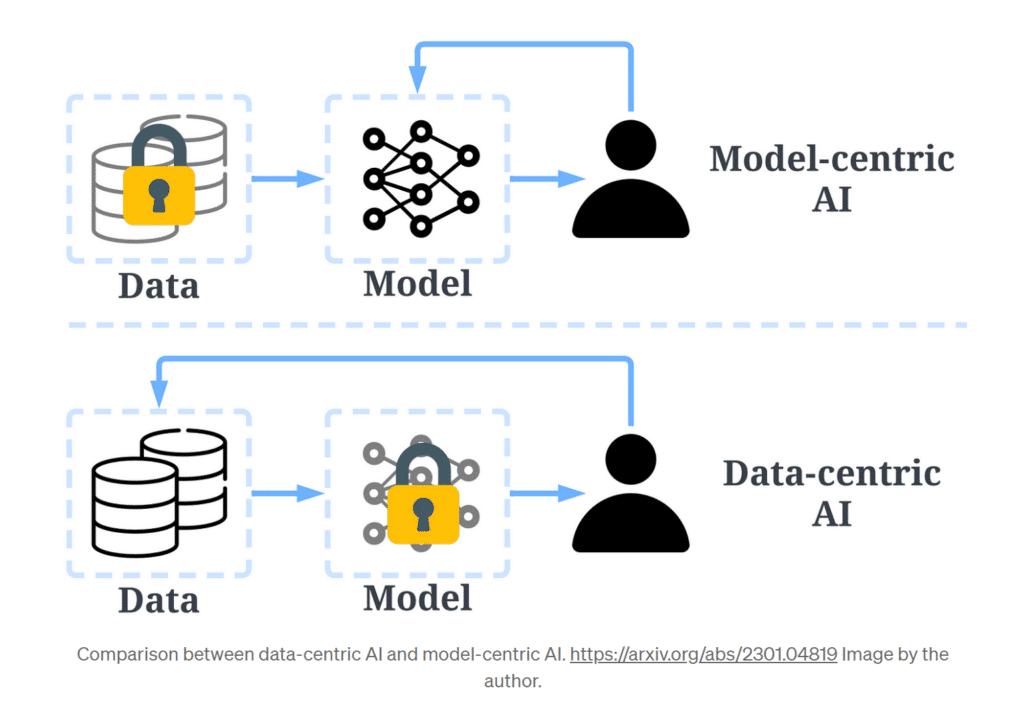
Next moves in GenAI
With the current pace at which AI technologies are advancing, it is challenging to make specific predictions, especially about their impact on the world of work. AI models have been acquiring new abilities at an astonishing rate, often surpassing the expectations of the researchers themselves. Despite this uncertainty, some emerging developments on the near horizon promise to have significant impacts on society:
- Evolution of language models: Current language models, such as GPT-4, Claude, Gemini and Llama, are expected to continue to evolve. This will not only extend their text comprehension and generation capabilities, but could also introduce new forms of human-machine interaction, making interfaces even more intuitive, natural and capable;
- Competition between closed-source and open-source models: The competition between closed-source models, represented by companies such as OpenAI and Microsoft, and open-source models, led by entities such as Meta, with Google positioning itself between the two extremes, will shape the future development of AI. This dynamic will influence accessibility, security, research collaboration and the development of AI-based applications;
- Small Language Models: In response to the demand for more sustainable and efficient solutions, small language models are expected to grow. These models, adapted to specific knowledge niches, promise to offer high precision and lower resource consumption, making them better suited to specialized applications;
- Expansion of AI infrastructure: The infrastructure that enables current advances in AI, provided by giants such as AWS, Google and Microsoft (all using Nvidia as their GPU processor), will continue to expand. This will ease the development and implementation of more advanced AI models, supporting an even wider range of applications;
- Robotization and machine vision: Projects like Tesla’s Optimus, which involves the development of humanoid robots capable of manipulating objects with extremely high precision, highlight the potential of combining robotization and machine vision. These technologies will advance beyond factories, integrating into everyday life in innovative ways, from domestic tasks to assistance in complex environments such as hospitals and public spaces. Another initiative in this segment, the startup Figure has developed a humanoid robot equipped with OpenAI’s GPT and has received funding from big names such as Jeff Bezos, Microsoft and Nvidia;
- AGI (Artificial General Intelligence): The search for AGI, considered the “holy grail” of this field, continues to guide the efforts of companies such as OpenAI, Google and Meta. The aim is to develop a type of superintelligence that will be able to surpass human capacity and thus take us to new levels of development hitherto unseen in our history. Again, although it is difficult to make precise predictions, we have never been so close to this scenario, although we don’t know if we are 5, 10 or 20 years away from it; and
- Safety and alignment: As AI becomes more integrated into our lives, safety and aligning the goals of AI models with human values become crucial. This involves not only protecting AI systems from malicious use, but also ensuring that they run ethically and in line with collective well-being.
In summary, these developments point to a future in which generative AI will play increasingly central roles in our society, challenging us to adapt, innovate and ensure that these technologies are developed and used responsibly and beneficially for all. Are you ready?
EloGroup is a Transformation consultancy that already works on Generative Artificial Intelligence projects in large corporations and is ready to help your organization follow a safe and sustainable path with its own tried and tested method, capable of unlocking the potential of generative AI in business and helping you find new levels of value generation.
Want to know more? Talk to us!







